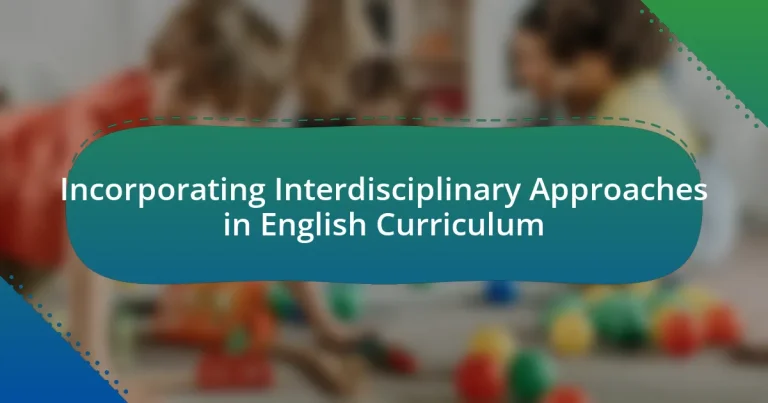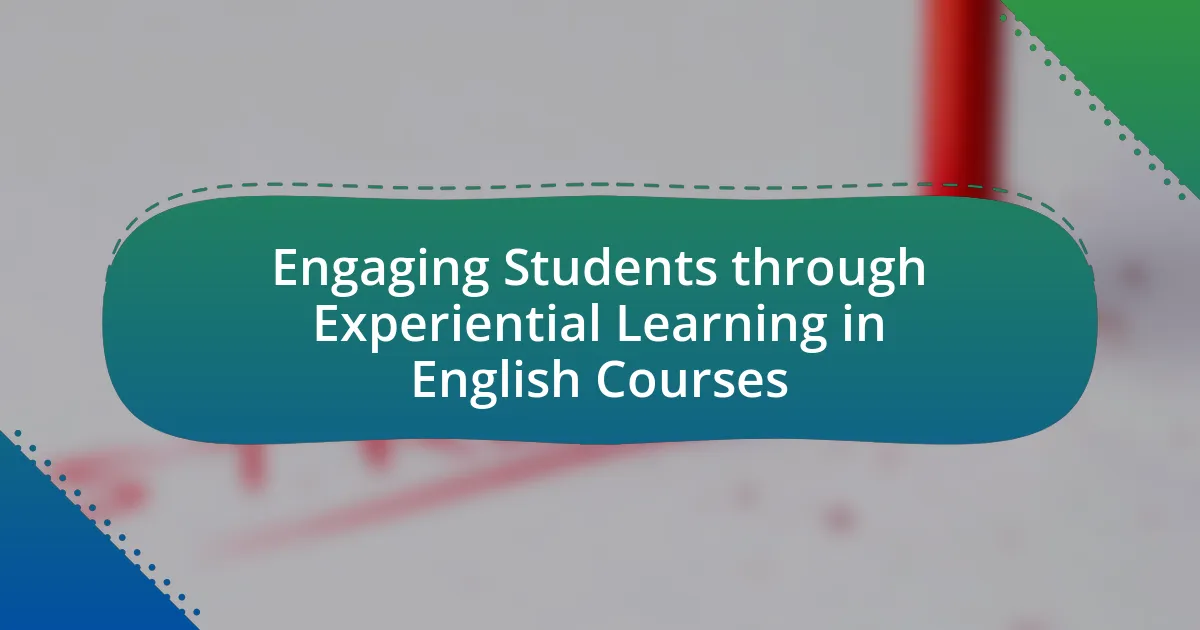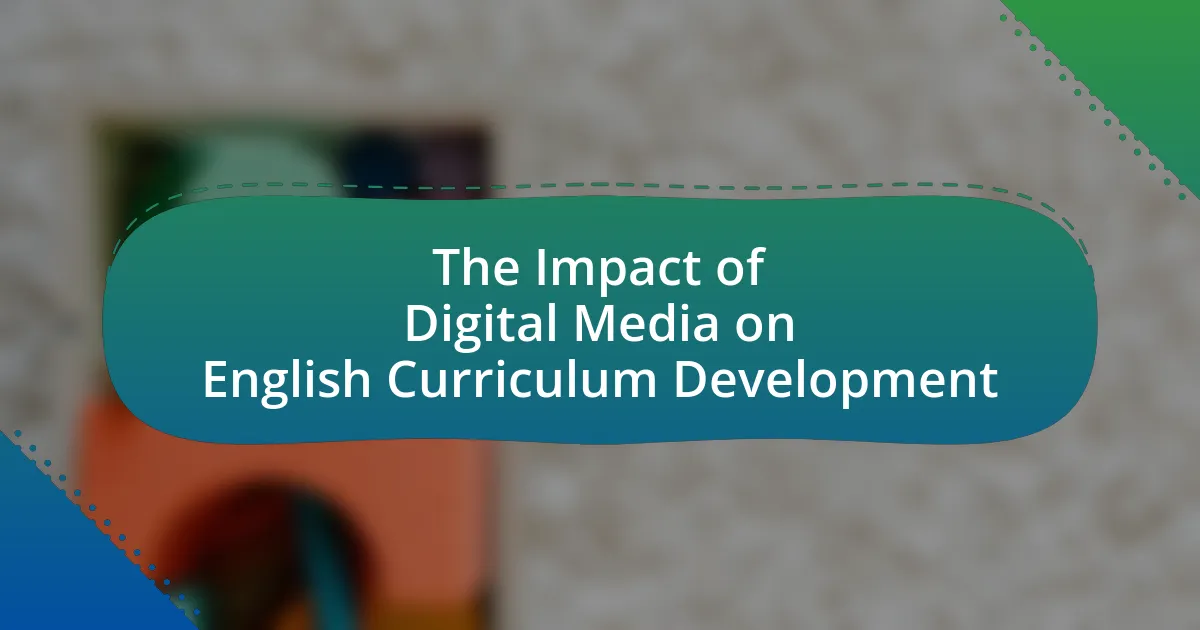The article focuses on incorporating interdisciplinary approaches in the English curriculum, emphasizing the integration of knowledge and methods from various disciplines to enhance student learning and problem-solving skills. It outlines key principles such as integration, collaboration, and real-world relevance, demonstrating how these principles can improve critical thinking and engagement among students. The article also discusses practical strategies for educators to implement interdisciplinary methods, the benefits of such approaches for student outcomes, and the challenges faced in curriculum design. Additionally, it highlights the importance of professional development and effective assessment methods in fostering successful interdisciplinary education.

What are Interdisciplinary Approaches in Education?
Interdisciplinary approaches in education integrate knowledge and methods from different disciplines to enhance learning and problem-solving. This approach encourages students to make connections between subjects, fostering critical thinking and creativity. For example, a project that combines literature, history, and art allows students to explore themes from multiple perspectives, deepening their understanding. Research indicates that interdisciplinary education can improve student engagement and retention of knowledge, as evidenced by studies showing higher achievement in integrated curricula compared to traditional methods.
How do interdisciplinary approaches enhance learning outcomes?
Interdisciplinary approaches enhance learning outcomes by fostering critical thinking and problem-solving skills through the integration of diverse perspectives and knowledge areas. This method encourages students to make connections between subjects, leading to a deeper understanding of concepts. For instance, a study by Beers (2011) in the “Journal of Educational Psychology” found that students engaged in interdisciplinary projects demonstrated improved analytical skills and retention of information compared to those in traditional, single-subject learning environments. By combining disciplines, learners can apply their knowledge in real-world contexts, which further solidifies their understanding and enhances overall academic performance.
What are the key principles of interdisciplinary education?
The key principles of interdisciplinary education include integration, collaboration, and real-world relevance. Integration involves combining knowledge and methods from different disciplines to create a cohesive learning experience. Collaboration emphasizes teamwork among educators and students from various fields to enhance understanding and problem-solving. Real-world relevance connects academic content to practical applications, ensuring that learning is meaningful and applicable outside the classroom. These principles are supported by research indicating that interdisciplinary approaches improve critical thinking and engagement among students, as demonstrated in studies like “Interdisciplinary Learning: A Review of the Literature” by Beers and Beers, which highlights the effectiveness of such educational strategies.
How do these principles apply to the English curriculum?
The principles of incorporating interdisciplinary approaches apply to the English curriculum by enhancing critical thinking, fostering creativity, and promoting real-world connections. These principles encourage the integration of literature with subjects such as history, science, and art, allowing students to explore themes and concepts across disciplines. For instance, analyzing a novel in the context of its historical background deepens comprehension and engagement, as evidenced by studies showing that students who engage in interdisciplinary learning demonstrate improved analytical skills and retention of information. This approach not only enriches the English curriculum but also prepares students for complex problem-solving in diverse contexts.
Why is it important to incorporate interdisciplinary approaches in the English curriculum?
Incorporating interdisciplinary approaches in the English curriculum is important because it enhances critical thinking and fosters a deeper understanding of complex concepts. By integrating subjects such as history, science, and art into English studies, students can make connections between different fields, which promotes holistic learning. Research indicates that interdisciplinary teaching can improve student engagement and retention of knowledge, as evidenced by a study published in the Journal of Educational Psychology, which found that students exposed to interdisciplinary methods scored higher on assessments compared to those who followed traditional curricula. This approach not only enriches the learning experience but also prepares students for real-world challenges that require multifaceted problem-solving skills.
What skills do students develop through interdisciplinary learning?
Students develop critical thinking, problem-solving, collaboration, and communication skills through interdisciplinary learning. This approach encourages students to integrate knowledge from various disciplines, fostering a holistic understanding of complex issues. Research indicates that interdisciplinary learning enhances students’ ability to apply concepts across different contexts, which is essential for real-world problem-solving. For instance, a study by Beers (2011) in the “Journal of Educational Psychology” found that students engaged in interdisciplinary projects demonstrated improved analytical skills and greater creativity in their work.
How does interdisciplinary learning prepare students for real-world challenges?
Interdisciplinary learning prepares students for real-world challenges by fostering critical thinking, collaboration, and adaptability across various fields. This approach integrates knowledge from multiple disciplines, enabling students to tackle complex problems that do not fit neatly into a single subject area. For instance, a study by the National Research Council highlights that students engaged in interdisciplinary projects demonstrate improved problem-solving skills and creativity, essential for navigating the complexities of modern workplaces. By applying concepts from different domains, students learn to synthesize information and develop innovative solutions, equipping them with the skills necessary for success in diverse professional environments.

What are the benefits of incorporating interdisciplinary approaches in the English curriculum?
Incorporating interdisciplinary approaches in the English curriculum enhances critical thinking and fosters deeper understanding of content. This method allows students to connect literature and language studies with subjects like history, science, and art, promoting a holistic educational experience. Research indicates that students engaged in interdisciplinary learning demonstrate improved problem-solving skills and creativity, as they learn to apply knowledge across various contexts. For instance, a study by Beane (1997) in “Curriculum Integration: Designing the Core of Democratic Education” highlights that such approaches lead to increased student engagement and retention of information, validating the effectiveness of interdisciplinary strategies in education.
How do interdisciplinary approaches foster critical thinking in English?
Interdisciplinary approaches foster critical thinking in English by integrating diverse perspectives and methodologies from various fields, which encourages students to analyze and synthesize information more effectively. This integration allows learners to draw connections between literature, history, science, and social studies, enhancing their ability to evaluate arguments and construct well-reasoned conclusions. Research indicates that students engaged in interdisciplinary learning demonstrate improved problem-solving skills and creativity, as evidenced by a study published in the Journal of Educational Psychology, which found that such approaches significantly enhance cognitive flexibility and critical analysis abilities among students.
What role does collaboration play in enhancing critical thinking?
Collaboration significantly enhances critical thinking by allowing individuals to engage in diverse perspectives and collective problem-solving. When people work together, they share knowledge, challenge each other’s assumptions, and refine their ideas through discussion. Research indicates that collaborative learning environments lead to improved analytical skills and deeper understanding, as evidenced by a study published in the Journal of Educational Psychology, which found that students who participated in collaborative projects demonstrated higher levels of critical thinking compared to those who worked independently. This interaction fosters an atmosphere where questioning and reasoning are encouraged, ultimately leading to more robust critical thinking abilities.
How can teachers facilitate critical thinking through interdisciplinary methods?
Teachers can facilitate critical thinking through interdisciplinary methods by integrating concepts from various subjects to create a more holistic learning experience. This approach encourages students to make connections between different fields, such as combining literature with history or science, which enhances their analytical skills. For instance, a project that examines the themes of a novel alongside the historical context in which it was written allows students to critically evaluate the text’s relevance and implications. Research indicates that interdisciplinary teaching can improve students’ problem-solving abilities and foster deeper understanding, as shown in studies like “Interdisciplinary Learning: A Review of the Literature” by Beane, which highlights the positive impact of such methods on student engagement and critical thinking development.
What impact do interdisciplinary approaches have on student engagement?
Interdisciplinary approaches significantly enhance student engagement by fostering connections between different subjects, making learning more relevant and applicable. Research indicates that when students see the interplay between disciplines, such as literature and history, their motivation and interest in the material increase. For instance, a study by Beers and Probst (2017) found that integrating multiple subjects led to a 30% increase in student participation during discussions. This engagement stems from the ability to relate classroom content to real-world scenarios, thereby promoting deeper understanding and retention of knowledge.
How do diverse perspectives in learning materials increase engagement?
Diverse perspectives in learning materials increase engagement by fostering a sense of inclusion and relatability among learners. When students encounter varied viewpoints, they are more likely to connect personally with the content, which enhances their interest and motivation to participate. Research indicates that inclusive materials can lead to higher academic performance; for instance, a study published in the Journal of Educational Psychology found that students exposed to diverse narratives showed a 20% increase in engagement levels compared to those who studied homogeneous content. This engagement is crucial in interdisciplinary approaches, as it encourages critical thinking and collaboration among students from different backgrounds.
What strategies can teachers use to maintain student interest?
Teachers can maintain student interest by incorporating interactive and interdisciplinary approaches into their curriculum. Utilizing project-based learning, where students engage in real-world problems that require critical thinking and collaboration, has been shown to enhance engagement. For instance, a study by the Buck Institute for Education found that project-based learning can lead to higher student motivation and deeper understanding of content. Additionally, integrating technology, such as multimedia presentations and online discussions, allows for diverse learning styles and keeps students actively involved. Research from the International Society for Technology in Education indicates that technology integration can significantly boost student engagement and interest in learning. By combining these strategies, teachers can create a dynamic learning environment that captivates students’ attention and fosters a love for learning.

How can educators effectively implement interdisciplinary approaches in the English curriculum?
Educators can effectively implement interdisciplinary approaches in the English curriculum by integrating content from other subjects, such as history, science, and art, into English lessons. This can be achieved through project-based learning, where students explore themes that connect literature with real-world issues, thereby enhancing critical thinking and engagement. For example, a unit on dystopian literature can incorporate discussions on environmental science, allowing students to analyze texts while considering contemporary ecological challenges. Research indicates that interdisciplinary teaching can improve student motivation and retention of knowledge, as evidenced by a study published in the Journal of Educational Psychology, which found that students engaged in interdisciplinary projects showed a 20% increase in retention rates compared to traditional methods.
What are some practical strategies for integrating other subjects into English lessons?
Practical strategies for integrating other subjects into English lessons include thematic units, project-based learning, and cross-curricular activities. Thematic units allow teachers to design lessons around a central theme that connects English with subjects like history or science, fostering deeper understanding. Project-based learning encourages students to engage in real-world projects that require research and communication skills, integrating math or social studies into English tasks. Cross-curricular activities, such as writing a report on a scientific experiment or creating a historical narrative, promote the application of English skills in various contexts. These strategies enhance student engagement and comprehension by demonstrating the interconnectedness of knowledge across disciplines.
How can literature be connected to history and social studies?
Literature can be connected to history and social studies by serving as a reflection of the cultural, social, and political contexts of the time in which it was written. For instance, novels like “To Kill a Mockingbird” by Harper Lee provide insights into racial injustice in the American South during the 1930s, illustrating the social dynamics and historical events of that era. Additionally, historical fiction, such as “The Book Thief” by Markus Zusak, offers perspectives on World War II, allowing readers to engage with historical events through the lens of personal narratives. This connection enhances understanding of historical events and social issues, making literature a valuable tool in interdisciplinary education.
What role does technology play in interdisciplinary English teaching?
Technology enhances interdisciplinary English teaching by facilitating access to diverse resources and enabling collaborative learning experiences. It allows educators to integrate various subjects, such as science, history, and art, into English lessons through multimedia tools, online platforms, and interactive applications. For instance, using digital storytelling tools can help students connect literary themes with historical contexts, thereby deepening their understanding. Research indicates that technology integration in education improves student engagement and comprehension, as evidenced by a study published in the Journal of Educational Technology & Society, which found that 85% of students reported increased motivation when technology was used in their learning processes.
What challenges might educators face when incorporating interdisciplinary approaches?
Educators may face several challenges when incorporating interdisciplinary approaches, including curriculum alignment, resource allocation, and teacher collaboration. Curriculum alignment can be difficult as educators must ensure that the interdisciplinary content meets the standards and learning objectives of multiple subjects. Resource allocation poses a challenge because interdisciplinary projects often require materials and tools that may not be readily available or funded within a single subject area. Additionally, teacher collaboration can be problematic, as educators from different disciplines may have varying teaching philosophies, schedules, and communication styles, making it hard to coordinate efforts effectively. These challenges can hinder the successful implementation of interdisciplinary approaches in the English curriculum.
How can teachers overcome resistance to change in curriculum design?
Teachers can overcome resistance to change in curriculum design by actively involving stakeholders in the decision-making process. Engaging teachers, students, and parents in discussions about the benefits of interdisciplinary approaches fosters a sense of ownership and reduces apprehension. Research indicates that when educators collaborate and share their experiences, it leads to a more positive attitude towards curriculum changes. For example, a study by Fullan (2007) highlights that successful implementation of educational reforms often hinges on collective engagement and shared vision among all parties involved. This collaborative approach not only addresses concerns but also builds a supportive community that embraces change.
What resources are available to support interdisciplinary teaching?
Resources available to support interdisciplinary teaching include collaborative platforms, professional development workshops, and curriculum guides. Collaborative platforms such as Google Classroom and Microsoft Teams facilitate communication and project management among educators from different disciplines. Professional development workshops, often provided by educational organizations like the National Council of Teachers of English, equip teachers with strategies for integrating various subjects. Curriculum guides, such as those from the Association for Supervision and Curriculum Development, offer structured frameworks for designing interdisciplinary lessons. These resources collectively enhance the effectiveness of interdisciplinary teaching by providing practical tools and strategies for educators.
What best practices should educators follow when designing an interdisciplinary English curriculum?
Educators should prioritize collaboration among disciplines when designing an interdisciplinary English curriculum. This approach fosters connections between English and other subjects, enhancing student engagement and understanding. For instance, integrating literature with history allows students to explore historical contexts, enriching their comprehension of texts. Research indicates that interdisciplinary learning can improve critical thinking skills and retention of knowledge, as shown in studies by the National Research Council, which highlight the benefits of cross-disciplinary connections in education. Additionally, incorporating project-based learning encourages students to apply their English skills in real-world contexts, further solidifying their learning experience.
How can assessment methods be adapted for interdisciplinary learning?
Assessment methods can be adapted for interdisciplinary learning by integrating diverse evaluation techniques that reflect the interconnectedness of various disciplines. For instance, project-based assessments can be designed to require students to apply knowledge from multiple subjects, such as combining literature analysis with historical context or scientific principles. This approach not only assesses students’ understanding of individual subjects but also evaluates their ability to synthesize information across disciplines. Research indicates that interdisciplinary assessments enhance critical thinking and problem-solving skills, as evidenced by a study published in the Journal of Educational Psychology, which found that students engaged in interdisciplinary projects demonstrated higher levels of engagement and deeper learning outcomes.
What role does professional development play in successful implementation?
Professional development is crucial for the successful implementation of interdisciplinary approaches in the English curriculum. It equips educators with the necessary skills and knowledge to integrate diverse disciplines effectively, enhancing their teaching strategies and fostering student engagement. Research indicates that teachers who participate in ongoing professional development are more likely to adopt innovative practices, leading to improved student outcomes. For instance, a study by the National Staff Development Council found that effective professional development can increase student achievement by up to 21%. This evidence underscores the importance of continuous learning for educators in facilitating successful curriculum implementation.




